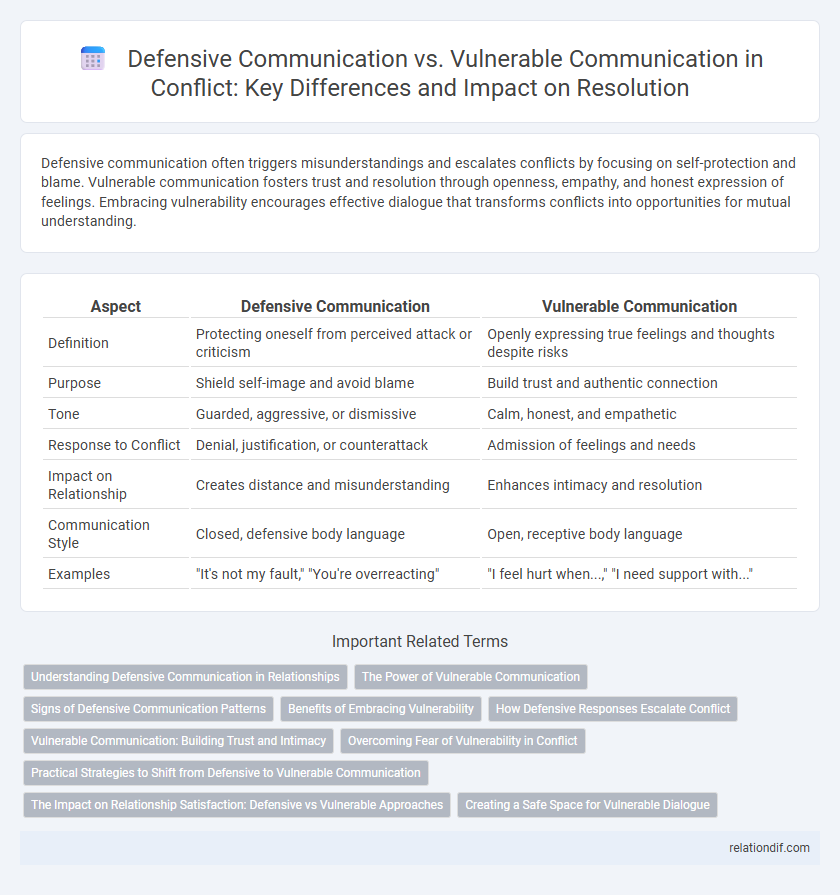Defensive communication often triggers misunderstandings and escalates conflicts by focusing on self-protection and blame. Vulnerable communication fosters trust and resolution through openness, empathy, and honest expression of feelings. Embracing vulnerability encourages effective dialogue that transforms conflicts into opportunities for mutual understanding.
Table of Comparison
| Aspect | Defensive Communication | Vulnerable Communication |
|---|---|---|
| Definition | Protecting oneself from perceived attack or criticism | Openly expressing true feelings and thoughts despite risks |
| Purpose | Shield self-image and avoid blame | Build trust and authentic connection |
| Tone | Guarded, aggressive, or dismissive | Calm, honest, and empathetic |
| Response to Conflict | Denial, justification, or counterattack | Admission of feelings and needs |
| Impact on Relationship | Creates distance and misunderstanding | Enhances intimacy and resolution |
| Communication Style | Closed, defensive body language | Open, receptive body language |
| Examples | "It's not my fault," "You're overreacting" | "I feel hurt when...," "I need support with..." |
Understanding Defensive Communication in Relationships
Defensive communication in relationships arises when individuals perceive threats to their self-esteem or autonomy, leading to behaviors such as denial, counterattack, or withdrawal that hinder effective conflict resolution. This communication style often creates a cycle of mistrust and emotional distance, reducing empathy and openness between partners. Recognizing defensive patterns enables couples to shift towards vulnerability, fostering deeper understanding and trust essential for healthy relational dynamics.
The Power of Vulnerable Communication
Vulnerable communication fosters trust and deeper understanding in conflicts by encouraging openness and emotional honesty, contrasting with defensive communication that often escalates tension and defensiveness. Expressing feelings without blame allows individuals to connect authentically, promoting conflict resolution and relational growth. Research shows that vulnerability reduces misunderstanding and creates a safe environment for collaborative problem-solving.
Signs of Defensive Communication Patterns
Defensive communication patterns often manifest through excessive justification, frequent interruptions, and dismissive body language, signaling resistance to open dialogue. Individuals displaying defensiveness may use sarcastic remarks or exaggerate threats, creating barriers to conflict resolution. Recognizing these signs enables the shift towards vulnerable communication, fostering trust and empathy in conflict situations.
Benefits of Embracing Vulnerability
Embracing vulnerability in conflict communication fosters authentic connections by encouraging openness and empathy, which reduces misunderstandings and defensiveness. Vulnerable communication enhances trust and collaboration, promoting resolution through shared feelings rather than blame. This approach leads to healthier relationships by prioritizing emotional honesty over rigid self-protection mechanisms characteristic of defensive communication.
How Defensive Responses Escalate Conflict
Defensive communication triggers a cycle of blame and mistrust that intensifies conflicts by prompting reactive aggression and emotional withdrawal. When individuals respond defensively, they often misinterpret intent, fueling misunderstandings and reinforcing negative patterns that escalate tension. Vulnerable communication, in contrast, fosters openness and empathy, breaking the defensive cycle and promoting conflict resolution through mutual understanding.
Vulnerable Communication: Building Trust and Intimacy
Vulnerable communication fosters trust and intimacy by encouraging openness and emotional honesty, which strengthens relationships even in conflict situations. Unlike defensive communication that often triggers misunderstandings and emotional barriers, vulnerability invites empathy and deeper connection. This approach promotes a safe space for authentic dialogue, reducing hostility and enhancing mutual understanding.
Overcoming Fear of Vulnerability in Conflict
Overcoming fear of vulnerability in conflict involves embracing open, honest communication that allows emotions and concerns to be expressed without defensiveness. Defensive communication often triggers blame and withdrawal, hindering resolution, while vulnerable communication fosters trust and empathy, enabling constructive dialogue. Practicing vulnerability reduces anxiety around conflict, promoting mutual understanding and collaborative problem-solving.
Practical Strategies to Shift from Defensive to Vulnerable Communication
Practicing active listening and expressing emotions with clarity fosters vulnerable communication, reducing defensiveness in conflicts. Using "I" statements instead of "you" accusations helps shift from blame to personal experience, encouraging openness and understanding. Creating a safe environment by acknowledging others' perspectives and avoiding judgment promotes trust and constructive dialogue.
The Impact on Relationship Satisfaction: Defensive vs Vulnerable Approaches
Defensive communication often leads to misunderstandings and emotional distance, negatively affecting relationship satisfaction by fostering mistrust and resentment. Vulnerable communication, characterized by openness and empathy, promotes deeper connection and mutual understanding, enhancing relationship satisfaction. Studies show couples practicing vulnerability report higher levels of intimacy and conflict resolution success, highlighting its positive impact on relational health.
Creating a Safe Space for Vulnerable Dialogue
Defensive communication often triggers resistance and blocks honest dialogue, whereas vulnerable communication fosters openness by expressing fears and needs authentically. Creating a safe space for vulnerable dialogue requires active listening, empathy, and non-judgmental responses to reduce perceived threats. This environment encourages trust, allowing individuals to share honestly and resolve conflicts constructively.
Defensive communication vs vulnerable communication Infographic

 relationdif.com
relationdif.com